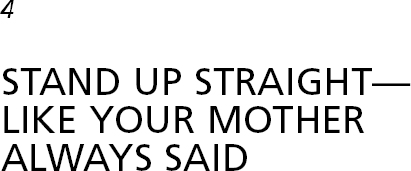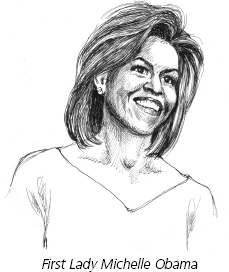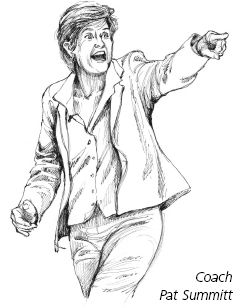The Well-Spoken Woman (11 page)
Read The Well-Spoken Woman Online
Authors: Christine K. Jahnke

Applause Principles: Be the Voice of Authority
- The voice, visual, and vocal components are the three integral ways to connect with an audience.
- Strengthen your voice to get the respect you deserve.
- Record your regular speaking voice to assess strengths and weaknesses.
- Use practice exercises to expand your vocal range and capabilities.
- Vocal variability is sweet music to the ears.

Â
So I learned how to throw a ballâand a right crossâas well as any boy in my neighborhood.
âFirst Lady Michelle Obama,
International Olympic Committee Address, October 2009
Â
Â
M
ichelle Obama says she shared the gift of sports with her father, who taught her how to compete with all the kids in the South Shore neighborhood of Chicago. With Fraser Robinson's guiding hand, she learned “self-confidence, teamwork, and how to compete as an equal.”
1
Obama has brought that athletic sensibility to the White House as she works to keep herself, her family, and America's children physically fit. This interest and active participation in sports motivates others to exercise and contributes to her success as a public speaker.
The love of sports was the topic of Michelle Obama's first international address as First Lady. The announcement that the First Couple would join the US Olympic Committee in Denmark to support the bid for the 2016 games in Chicago generated serious buzz in the sporting community and beyond. The world was caught up in the excitement of the new Obama presidency. At the Team USA headquarters hotel in Copenhagen, euphoria broke out with the news that the president and the First Lady would both speak to the International Olympic Committee. Many felt that their presence would be the crowning touch that would secure America's victory against the other finalist countries. Although it did not work out that way in the end, it was an exhilarating experience for all.
As a member of the speech-coaching team that had been prepping the Olympic athletes and officials for their remarks, I was thrilled to learn I would rehearse with the First Lady. The initial coaching session was scheduled to take place just hours after Air Force One touched down. Due to tight security, we could not work in the specially designed training center equipped with digital cameras and big-screen playback. Arrangements were made to meet in the hotel where many foreign dignitaries were staying and where Secret Service could better control access. The practice space was an ordinary hotel roomânot the presidential suiteâwith the bed removed to make way for a speaker's lectern and the teleprompter. As often is the case when working with high-profile clients, the catered food was better than usual, but the accommodations were spontaneously thrown together.
Olympic Workout
The First Lady arrived for the first session slightly out of breath, having just completed a series of one-on-one meetings with voting members of the Olympic committee. If she was suffering from jet lag, the only sign she gave was kicking off her heels to give her feet a break. Otherwise, she looked stunning in a signature designer dress and seemed ready to get to work immediately. The initial runthrough was the first chance Obama had to review the remarks, which were a loving tribute to her father. She reminisced about watching former Olympic stars “Nadia and Olga” while nestled in his lap. She also recalled the time he spent with his children on the ball field even after his multiple sclerosis forced him to use crutches. The narrative of the speech captured “the sense of unbridled possibility” that Obama's
father had instilled in her and the lasting effect of watching Olympians excel in competition.

After a few practice runs, I noticed that the First Lady's posture appeared a bit slumped in the shoulders. She explained that she had been previously instructed to “settle in” when standing at a lectern and demonstrated how she was leaning on it by placing her hands and forearms on top. This was a bad suggestion for a woman who stands nearly six feet tall in her stocking feet because it caused her shoulders to hunch forward. I quickly showed her how she could maximize her stature by using the “champion stance.” She graciously accepted the feedback and immediately felt the improvement. It worked well for her, and I think she was pleased with that advice. The champion stance is the fix for all posture issues because it helps everyone project a strong presence; the stance works for First Ladies as well as for women of all heights. You'll find more details on how you can use it in the “Well-Spoken Woman's Body Language Playbook” section of this chapter.
Despite a Herculean effort by the First Lady and the president, the international committee awarded the games to Brazil. However, the news media coverage of the US delegation described the First Lady's remarks as the presentation's emotional core. In a shimmering yellow dress, “the First Lady stood out like a star in front of a backup chorus.”
2
According to CNN, Obama stole the show, taking home a “gold medal” with her personal story of people like her father “who face seemingly insurmountable challenges, but never give up.”
3
Moreover, she carried herself like a winner.
IMPRESSION MANAGEMENT
Well-spoken women get their bodies into the act, and who knows better than athletes how to move with dexterity and strength. Giving it your all on court or onstage is physically exhausting. The initial rush of adrenalin causes the heart to race and palms to sweat. The firing of brain cells provides mental alertness and the ability to concentrate. The vocal cords get a workout projecting to the back of the room. After a twenty-minute talk, it can feel as if
you have just run a brisk mile. The best speakers, like the best athletes, strive for every physical advantage to achieve peak performance.
Do you know what your body language is communicating? Are you sending accurate signals about competence and readiness? Do distracting mannerisms mask your true potential? Is your posture submissive? Hand gestures aggressive? Eye contact nonexistent? This chapter takes up the second of the three Vs of communicationâthe visual. How you look has the strongest overall impact on your audience. It is more memorable than what you say. Many presenters do not realize the impact of body language. When TV's Mary Richards joyfully tosses her hat in the air, we feel her exuberance and root for her to “make it after all.” Gestures large and small speak volumes. If you haven't considered your physicality, you might be surprised to learn what you are communicating while you are talking.
The Disconnect of Cognitive Dissonance
Cognitive dissonance refers to a disconnect that exists between what you think you did and how you actually came across. With cognitive dissonance, your self-image is blurred. For example, you thought it went well, but the audience was distracted by your constant finger tapping and couldn't pay attention to what you said. Or you felt you bombed because of your shaky hands and quivering voice; meanwhile, the audience never noticed because they were being blown away by your creative PowerPoint® presentation. For an accurate sense of what you project, you need to watch yourself in action. Verbal feedback from a colleague likely isn't sufficient to help you accurately process the performance.
At the suggestion of her boss, a lobbyist for an education group came in for a public speaking training session. She had been told that her rushed, jumbled presentation style was causing others to question her competence. When we met, the first thing out of her mouth was “People tell me I talk fast.” She repeated this several times, very quickly: “I know I talk fast, I have always talked fast. I can't stop talking so fast.” Despite her acknowledgment of the feedback, it hadn't sunk in that she needed to change if she was going to improve. When we played back the training tape, she experienced a revelatory flash. “Boy, I really
do
talk fast!” The rushed words were
accompanied by jerky hand movements and darting eyes. She finally saw how her frenetic style came across to others. Reviewing practice tapes can help you break through the cloud of misperception that can be created by cognitive dissonance.
The Coaches' Coach
No one is better positioned to focus on the fundamentals of body language than the world's most successful basketball coach. Pat Summitt was named head coach of the University of Tennessee Lady Volunteers at the age of twenty-two, and thirty years later the school named the court for herâThe Summitt. She has won more college basketball games than any other coach, male or female. Coach Summitt preaches the gospel of “winners communicate.” This core belief in the necessity of communication has made the Lady Vol players winners on the court and off. Great coaches, like great speakers, learn lessons from wins and losses, and Summitt is no exception.
During NCAA tournament play, a photograph of the coach grabbing a player by the uniform and screaming at her was plastered on the front page of
USA Today.
Summitt lost her cool when the player celebrated a three-point shot late in the game rather than hustling down the court to play defense. The misstep resulted in an easy score for the opposing team. In the heat of the game, Summitt was upset with her player's lack of disciplineâbut not nearly as upset as she was when she saw the photo. Immediately she called the player's mother to reassure her: “I'm not abusing your child, I promise.”
4
While the Kodak moment of her “General Patton” style made instant headlines, Summitt isn't a
coach who throws chairs or punches. She is best known for telegraphing her legendary toughness with intense eye contact, otherwise known as “the stare.” The fierce look has been described as cold enough to freeze time. When her son Tyler sees the glare, he asks his mother to please put her sunglasses on. Given Coach Summitt's proclivity for the stare, it is not surprising that eye contact is the first technique the Lady Vol players must master. Summitt equates eye contact with self-respect and mutual respect: “It demonstrates that you are confident enough to look at the person who is speaking and that you will give her your full attention.”
5

THE WELL-SPOKEN WOMAN'S
BODY LANGUAGE PLAYBOOK
No visual technique is more important than establishing and maintaining eye contact with the audience. It is a sign of respect and it provides you with valuable feedback. How to make good eye contact is detailed here in the “Well-Spoken Woman's Body Language Playbook.” The playbook contains diagrams and descriptions of how to execute the essentials: eye contact, posture, movement, facial expression, and hand gestures. These drills will ensure that you avoid a Kodak moment and are ready with your game face on.
Step 1: Eye Contact
Don't use the Summit glare unless you want to drive people from the room. Staring or an intense gaze can create pressure or tension, whereas solid, steady eye contact can communicate trustworthiness, sincerity, and seriousness. Being able to look at the listeners is essential to establishing your presence and maintaining a connection with them. Poor-quality eye contact can blow your credibility in a matter of seconds. Weak or nonexistent eye contact can leave the impression you are unprepared or ill informed. Avoid the biggest mistakes that cheat you and the audience.
Eye contact is mutually beneficial. It helps the audience connect, and it provides you with feedback to accurately gauge how you doing. What
signals is the audience sending you? Do they appear to be attentive and listening? Do they look like they get it, or are they confused? Have you gone on too long? If they no longer make return eye contact, then they may be bored. The first two plays in the body language playbook are designed to help you keep your eye on the ball. The ball is always the listeners.
